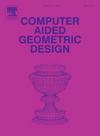黎曼流形上的三次de Casteljau构造和几类三次曲线
IF 1.7
4区 计算机科学
Q3 COMPUTER SCIENCE, SOFTWARE ENGINEERING
引用次数: 0
摘要
非欧几里得空间中的曲线插值对于轨迹规划、量子计算和图像配准具有重要意义。特别地,黎曼三次、Jupp和Kent三次以及张力的黎曼三次经常用于埃尔米特插值。除了在极少数情况下,这些曲线不能以封闭形式给出,这限制了它们的适用性。欧几里得空间中三次多项式的经典de Casteljau构造推广到黎曼流形中,其中线段被流形上的测地线弧代替。作者(Zhang和Noakes, 20119a)表明,广义三次de Casteljau曲线可以非常接近黎曼三次,误差由四阶曲率项限定。在此基础上,本文旨在分析在张力条件下近似于Jupp、Kent三次和riemann三次的广义三次de Casteljau曲线的质量。我们还修改了广义de Casteljau算法,以构造更接近于Jupp和Kent立方的曲线,以及更接近于张力的黎曼立方的曲线。我们通过在二维单位球S2和特殊正交群SO(3)中的三次曲线上的数值实验来说明我们的理论结果。本文章由计算机程序翻译,如有差异,请以英文原文为准。
The cubic de Casteljau construction and some classes of cubic curves on Riemannian manifolds
The interpolation of data by curves in non-Euclidean spaces is important for trajectory planning, quantum computing and image registration. In particular, Riemannian cubics, Jupp and Kent cubics and Riemanninan cubics in tension are frequently used for Hermite interpolation. Except in very few cases, these curves cannot be given in closed form, which limits their applicability. The classical de Casteljau construction of cubic polynomials in Euclidean space has been generalized to Riemannian manifolds, where line segments are replaced by geodesic arcs on manifold. The authors (Zhang and Noakes, 2019a) showed that generalized cubic de Casteljau curves, can approximate Riemannian cubics quite closely, with error bounded by a 4th order curvature term. Motivated by that work, the present paper aims to analyze the quality of the generalized cubic de Casteljau curves approximating Jupp and Kent cubics, and Riemannian cubics in tension. We also modify the generalized de Casteljau algorithm to construct curves that are closer to Jupp and Kent cubics, and to Riemannian cubics in tension. We illustrate our theoretical results by numerical experiments on cubic curves in the 2-dimensional unit sphere and also in the special orthogonal group .
求助全文
通过发布文献求助,成功后即可免费获取论文全文。
去求助
来源期刊

Computer Aided Geometric Design
工程技术-计算机:软件工程
CiteScore
3.50
自引率
13.30%
发文量
57
审稿时长
60 days
期刊介绍:
The journal Computer Aided Geometric Design is for researchers, scholars, and software developers dealing with mathematical and computational methods for the description of geometric objects as they arise in areas ranging from CAD/CAM to robotics and scientific visualization. The journal publishes original research papers, survey papers and with quick editorial decisions short communications of at most 3 pages. The primary objects of interest are curves, surfaces, and volumes such as splines (NURBS), meshes, subdivision surfaces as well as algorithms to generate, analyze, and manipulate them. This journal will report on new developments in CAGD and its applications, including but not restricted to the following:
-Mathematical and Geometric Foundations-
Curve, Surface, and Volume generation-
CAGD applications in Numerical Analysis, Computational Geometry, Computer Graphics, or Computer Vision-
Industrial, medical, and scientific applications.
The aim is to collect and disseminate information on computer aided design in one journal. To provide the user community with methods and algorithms for representing curves and surfaces. To illustrate computer aided geometric design by means of interesting applications. To combine curve and surface methods with computer graphics. To explain scientific phenomena by means of computer graphics. To concentrate on the interaction between theory and application. To expose unsolved problems of the practice. To develop new methods in computer aided geometry.
 求助内容:
求助内容: 应助结果提醒方式:
应助结果提醒方式:


